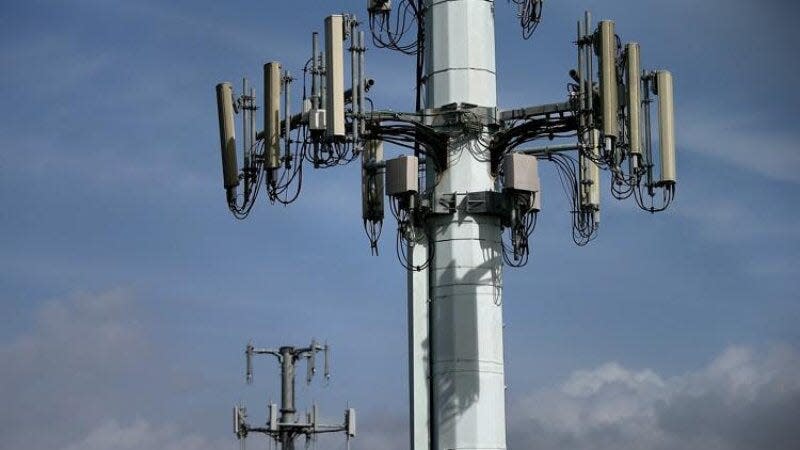Bucks County signals it's ready to reap rewards for hosting 5G antenna towers
Bucks County will cash in on new 5G wireless technology as the county commissioners have approved the installation of mini towers on county government buildings to allow wireless carriers to offer the most up-to-date high-speed service.
The commissioners approved the installations after hearing a presentation by Andrew Corrigan, a senior vice president for AON who represented 5G LLC of Bethesda, Maryland, the company which would broker the installations for the 23 wireless companies who will share the towers.
There are approximately 250 buildings on which the mini-towers could be placed, though not every site will be selected. "5G LLC will market the county’s properties to the 23 carriers deploying their 5G infrastructure. If a carrier is interested, 5G LLC will broker the deal for the county, " Corrigan said.

Corrigan said the county could be paid $3,000 to $5,000 per month for each installation. The county noted in its agenda that it would receive 75% of the revenue from the leases.
5G stands for the fifth generation of mobile technology, several sites on the Internet noted.
The organization Technical.ly explains the need for 5G to transmit data "as phones, tablets and other devices advanced. Now, if someone tries using data to stream music or a video in a 4G tower’s coverage area, that person might have trouble connecting if too many other devices are already using data provided through the tower.
"5G fixes some of those issues with small cell nodes. Affixed to streetlights or buildings, these are mini towers that accommodate both wireless and fiberoptic connections to supplement existing cell towers. This dual connection not only allows for much faster network speeds and increased wireless density — a big step in starting to resolve the digital divide underscored by the pandemic — but also provides better connection for regions in a 4G tower’s coverage area that might have been initially blocked by hills or tall buildings," Technical.ly stated in a website report.
Corrigan said that the United States currently has about 170,000 cell towers to provide 3G and 4G wireless service for cellphone and other users but it will need 3 million more devices to fully connect the country for 5G technology. The first 800,000 installed will be rooftop models that would stand up to 3 feet high and could be hidden from view. The next phase of the installation process would involve smaller, laptop sized units that could be placed on the ground or up to 10 feet high. They would be used to operate drones that could be used for delivery services, he explained. He said the businesses that host these devices will reap about $150 billion in lease fees.
Corrigan said at the meeting that there are "no health or safety complications at all with these antennas.” He later emailed a British Broadcasting Corp. article showing that the radio waves emitted from 5G devices is in the range of cell phones and microwaves. He also submitted a report from the FCC on health and safety with wireless devices.
The report states that several US government agencies and international organizations are monitoring research on the health effects of RF (radio frequency energy) exposure. "According to the FDA and the World Health Organization (WHO), among other organizations, to date, there is no consistent or credible scientific evidence of health problems caused by the exposure to radio frequency energy emitted by cell phones," it notes, but states that people concerned about the issue should try to limit cell phone use and exposure.
Safety was raised as an issue by several people who spoke at meetings in Newtown Township, which is part of a zoning jointure with Wrightstown and Upper Makefield over the installation of the mini-towers in the three municipalities. Newtown Township voted Sept. 14 not to consider a resolution on revisions to the local ordinance that currently addresses wireless towers until the revisions are worked out by all three municipalities. Chester Pogonowski of Wrightstown, who chairs the jointure, said the group has brought in a consulting attorney "to look at the ordinance we have and make it better."
But municipalities must approve placement of the mini-towers, as both the federal Small Cell Order of 2018 and Pennsylvania Act 50 of 2021 require local townships and boroughs to allow the installation of devices for 5G coverage in their communities to support national service.
According to the Pennsylvania Municipal League, Act 50 is “considered the gold standard as the most municipal friendly small cell legislation in the country” and is a win for local governments in Pennsylvania in allowing them to preserve zoning regulations affecting the small-cell tower installations, to collect fees and to be indemnified from harm caused in the installation, repair or maintenance of these devices in right of ways.
This article originally appeared on Bucks County Courier Times: Bucks County is ready to reap lease fees for hosting 5G antenna towers

